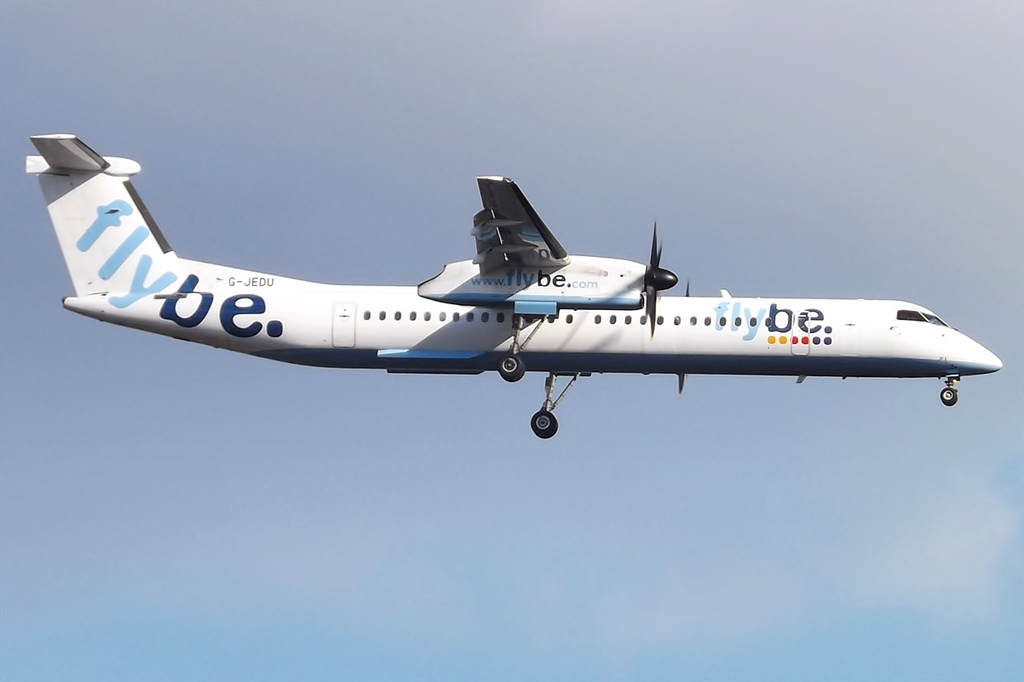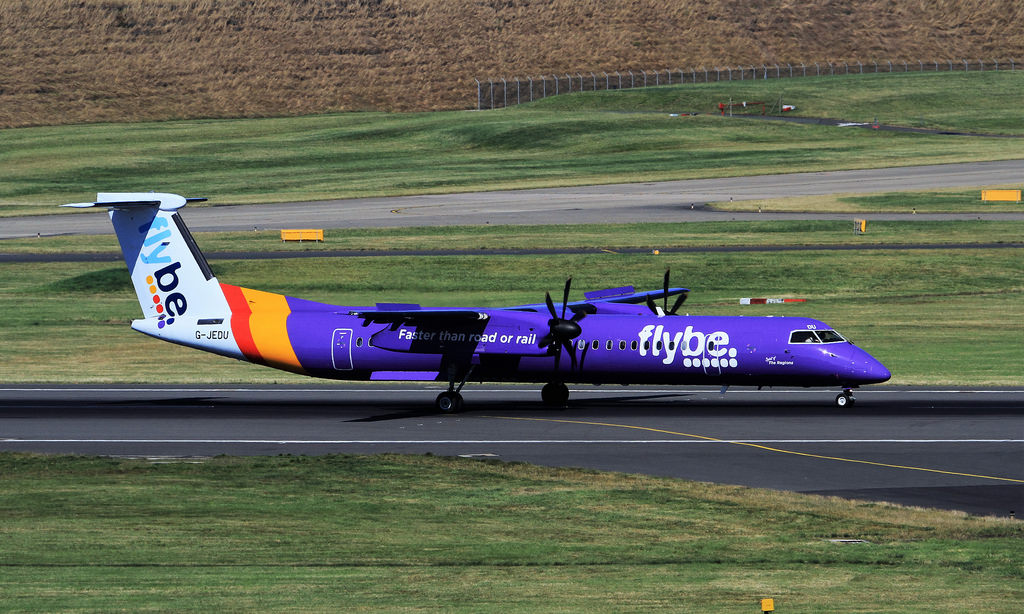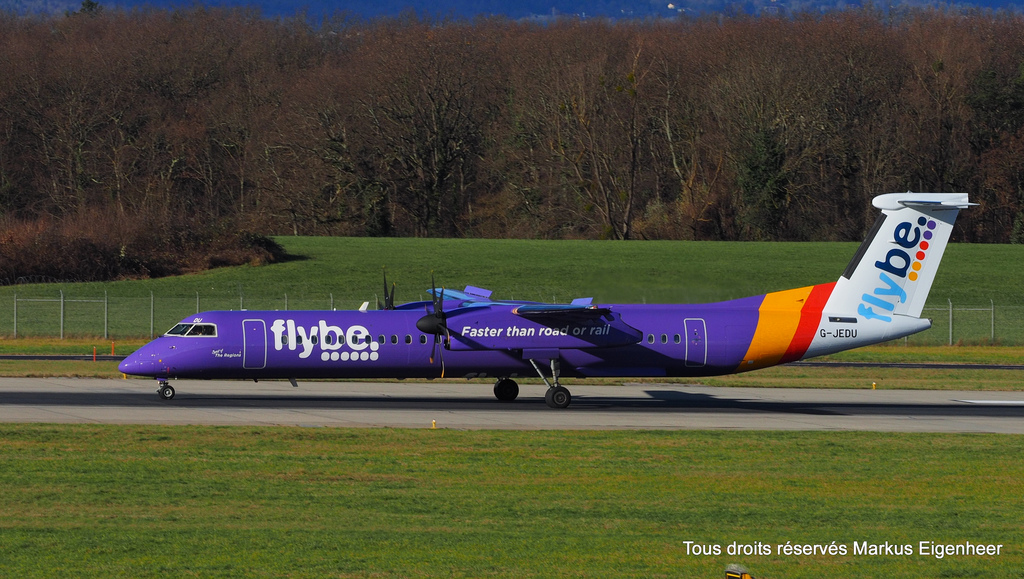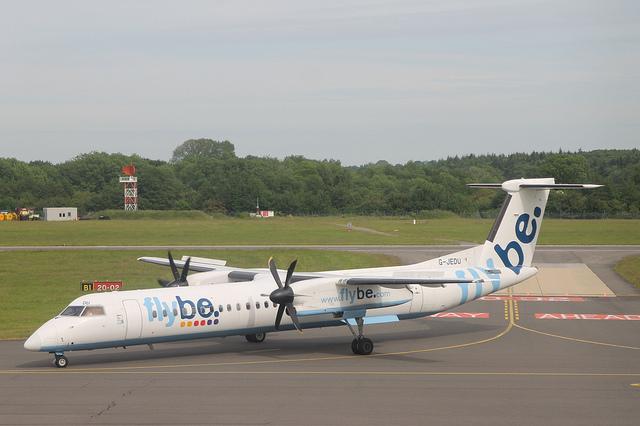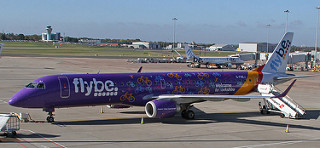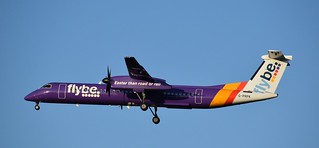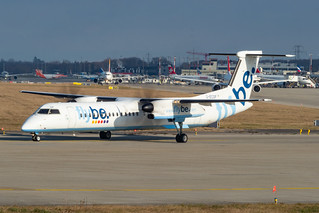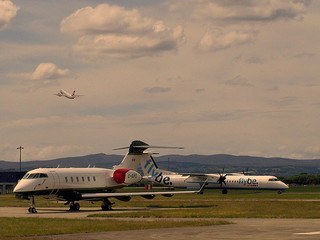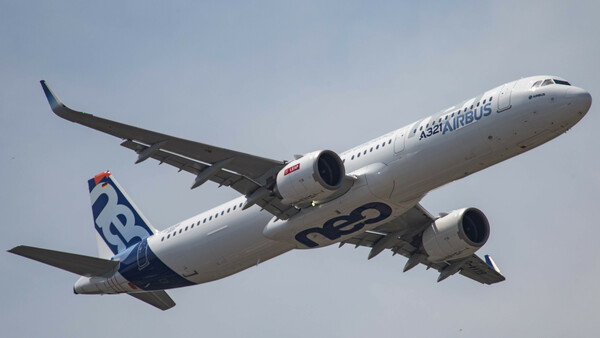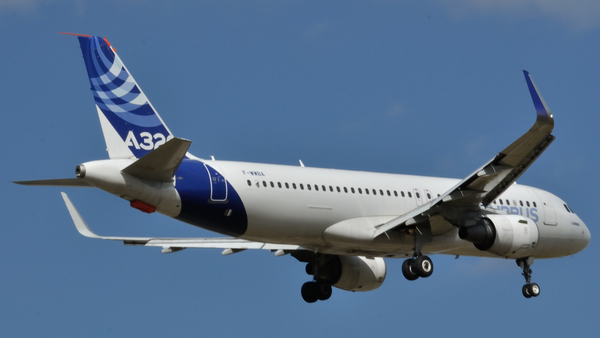Flybe DH8D at Belfast on Nov 10th 2017, gear problem, landed without nose gear
Last Update: May 16, 2019 / 16:58:26 GMT/Zulu time
Incident Facts
Date of incident
Nov 10, 2017
Classification
Accident
Cause
Gear problem
Airline
Flybe
Flight number
BE-331
Departure
Belfast City, United Kingdom
Destination
Inverness, United Kingdom
Aircraft Registration
G-JEDU
Aircraft Type
De Havilland Dash 8 (400)
ICAO Type Designator
DH8D
The airline confirmed flight BE-331 landed with the nose gear retracted. One passenger was taken to a hospital with a minor hand injury. There were 52 passengers plus one infant and 4 crew on board.
According to ground observers the aircraft's nose gear doors were open, however, the nose gear could not be seen obviously remaining locked up in the nose wheel well.
On Nov 14th 2017 the AAIB reported the nose gear failed to extend. The occurrence is being investigated by the AAIB.
On May 16th 2019 the AAIB released their final report concluding the probable causes of the accident were:
The investigation concluded that mechanical damage within the electrical harness of the primary ‘nose gear lock’ proximity sensor caused an intermittent and erroneous sensor state change during landing gear retraction. The measured inductance value associated with the sensor state change was not sufficiently high for the sensor to be flagged as faulted, and the erroneous state change was therefore considered valid. This had the effect of interrupting the NLG retraction sequence by causing the forward NLG doors to close prematurely while the NLG was still retracting, such that the tyres came into contact with the doors. When the NLG finally retracted, the tyres became jammed in the NLG bay, preventing it from extending when subsequently commanded. The flight crew followed the appropriate procedures for dealing with the incident, which led to the safe landing and evacuation.
Prior to this accident, the failure mode of an erroneous sensor state change below the threshold at which the sensor would declare itself faulted, had not previously been identified.
The investigation determined that the harness had been secured by a non-flexible cable tie, which restricted it from flexing during normal operation of the nose landing gear. This created loading cycles sufficient to create a cyclically-driven fatigue failure mechanism in the two conductor wires within the harness.
The aircraft manufacturer has taken action to clarify nose landing gear proximity harness routing and attachment instructions in relevant AMM tasks, and has published inspection requirements. The aircraft and landing gear manufacturers are working to identify a more flexible harness design.
The AAIB described the sequence of events:
Shortly after takeoff, the landing gear selector lever was selected to the up position. On the Landing Gear Control and Indication Panel (LGCIP) the crew observed that the landing gear green lights extinguished, the three red lights and the amber landing gear door lights as well as the amber light in the landing gear selector lever all illuminated. After a short time, all three red lights extinguished, the left and right door lights extinguished but the nose door light and the light in the landing gear selector lever remained illuminated. The crew kept the airspeed below the 185 kt landing gear limit speed and climbed to 4,000 feet, routing to waypoint Magee to take up the hold whilst they assessed the problem. The aircraft entered the hold at 1132 hrs and the total fuel onboard was 2,800 kg.
Whilst in the hold, the crew initially actioned the ‘LANDING GEAR FAIL TO RETRACT’ abnormal checklist followed by the ‘LANDING GEAR FAIL TO INDICATE LOCKED DOWN’ abnormal checklist. The MLG lowered and indicated locked down, but the NLG showed the unsafe indication with the amber nose door light still illuminated. The landing gear inoperative (ldg gear inop) caption also illuminated on the Caution and Warning Annunciator Panel. They actioned the ‘ALTERNATE LANDING GEAR EXTENSION’ abnormal checklist and made several attempts to operate the nose landing gear alternate release handle but the indications remained the same.
They reviewed the ‘EMERGENCY LANDING – ONE OR BOTH ENGINES OPERATING’ abnormal checklist and decided to divert to Belfast International Airport. At this stage, the crew did not know if the NLG was up or down. The crew sought advice from their company and this confirmed their decision to go to Belfast International Airport. They reviewed the fuel and decided to leave the hold with 1,100 kg which would minimise the fuel onboard at touchdown but ensure sufficient fuel to carry out a go-around if required.
...
At Belfast International Airport, Runway 25 was in use, the surface wind was 250º at 12 kt, visibility more than 10 km, clouds few at 1,800 feet and scattered at 2,900 feet, temperature +12ºC, dew point +3ºC, and the QNH 1020 hPa. The crew briefed for a radar vectored ILS approach for Runway 25 with full landing flap and an approach speed of 110 kt. They also reviewed the emergency landing actions and reminded themselves where the CVR/FDR circuit breakers were located in order to ensure they were pulled after landing.
The aircraft left the hold at 1320 hrs with 1,100 kg of fuel as planned and commenced the approach. All the normal checks were carried out and at about 4 nm, ATC informed them that the nose landing gear had not extended. The approach was continued as briefed and at 200 ft, the co-pilot gave the ‘BRACE’ command over the PA and all the passengers were seen to adopt this position.
The aircraft touched down at 1332 hrs on the main wheels and the nose was held off as the speed decayed and gently lowered onto the runway. As the aircraft came to a stop, both engines were shut down and when stopped, the commander ordered the evacuation.
The AAIB described first examination of the aircraft:
The aircraft nose was raised using airbags until a jack could be positioned on the forward jacking point. The NLG remained in the retracted position when the aircraft was lifted. It was evident that the NLG was not correctly centred, instead the wheels were turned to the right. The upper outside surface of the right tyre appeared to be jammed against the wall of the NLG bay.
The nose landing gear alternate release cable remained jammed despite attempts to pull it using substantial force, however the uplock could be heard releasing when the cable was pulled. A crowbar was used to rotate and centre the NLG, releasing the right tyre from the jammed position; once the gear was centred, it extended under gravity and locked down. Coincident with this the nose landing gear alternate release cable in the cockpit was heard to retract onto its spool.
Examination of the NLG identified evidence of blue paint on the outboard shoulders of both tyres, indicating that each tyre had come into contact with the outer painted surface of the respective forward NLG doors.
...
The aircraft was substantially damaged by deformation and abrasion due to runway contact. This resulted in structural damage to the lower front pressure bulkhead and fuselage skin. The forward NLG doors suffered substantial abrasion damage and were partially detached from the fuselage. The aft NLG doors were in the closed position with portions of the exterior surfaces abraded and worn down to the honeycomb. The nose landing gear trunnion assembly was also damaged.
The AAIB analysed the crew actions:
It was determined that the flight crew had followed all relevant procedures but the way the nose landing gear was jammed meant that the landing gear alternate extension procedures would not have been effective in lowering the NLG. Due to the position of the NLG, it is believed that as the pilot continued pulling the nose gear alternate release handle, the kicker arm was able to pass the pivot tube. This theory could explain why the nose landing gear alternate release cable did not rewind onto its spool. Following the accident, considerable force was required to release and re-centre the NLG before it was free to extend under gravity.
The AAIB analysed the gear retraction and sensor issues:
In normal landing gear operation, the NGLK1 and 2 proximity sensors are in the near state when the nose landing gear is in either the uplocked or downlocked position, and in the far state when the gear is in transit. Post-accident testing identified a condition where an erroneous state change of the NGLK1 proximity sensor from far to near while the gear was in transit could cause an unexpected output to the retract selector valve and the nose landing gear door sequence valve, interrupting the retraction sequence. When this occurred the forward NLG doors closed prematurely causing the gear to stall mid-retraction and the retraction would only recommence when the system logic conditions required for retraction were met.
The erroneous sensor state change was evidenced by an inductance spike on the PSEU, which although sufficient for the PSEU to detect a state change, was not high enough for the PSEU to flag the sensor as faulted.
This condition was consistently repeated during testing but occurred only intermittently and not on every retraction. There was variation in the timing at which the sensor state change occurred, its duration and the angle at which the gear stalled but it was evident during some retractions that interference between the NLG tyres and forward doors would have occurred, if the doors had been fitted. Flexing of the NGLK1 harness along its length while monitoring the displayed inductance values identified the possibility of mechanical damage in the harness, and this was subsequently confirmed by a CT scan.
Laboratory examination
Forensic examination of the NGLK1 and 2 harnesses identified that that the white polymer jacketing on both cables had failed on the concave side of a permanent set bend, just above the position of the shared p-clip 2, which attaches both harness to the drag strut. In both cases the shape of the failure suggested that the cables had been forced into and held in a tight bend with small radius.
The two layers of woven metal braiding had failed at the fault location in both harnesses. The fracture surfaces of the individual failed strands were observed to be normal to their own axis suggesting a fatigue failure mechanism. Higher magnification SEM examination of the fracture surfaces on the failed braiding strands from NGLK1 revealed fatigue striations, consistent with a cyclically-driven fatigue propagation failure mechanism. Striation spacing indicated that it would have taken at least 330 loading cycles to fail a single strand of braiding. The aircraft had completed 3,414 flight cycles since the NGLK1 and 2 harnesses were installed. The multiple landing gear retractions conducted during post-accident testing would also have contributed to the loading cycles on the harnesses.
Beneath the woven metal braiding of NGLK2, both insulated conductors were found intact and did not display any macro-indications of failure.
Beneath the woven metal braiding of NGLK1, one of the multi-stranded conductors (white with blue stripe) exhibited a complete through-thickness bulk fracture, including the two layers of insulation, as well as multiple transverse fractures on individual wire strands either side of the bulk fracture. As the conductor was still largely retained within its insulation, it was apparent that an electrical path could still have existed across the bulk fracture, bridged by short lengths of wire strands. The second conductor (plain white) displayed many transverse fractures on individual wire strands, predominantly on the concave side of the bend and although the failure had not progressed to a bulk fracture, it was on the way to creating one. The fracture surfaces from the bulk fracture on the blue-striped wire, and those on individual wire strands from both conductors, displayed flat transverse fractures that were typical of fatigue that propagated away from sites of fretting. The fretting marks suggested relative movement between wire strands, which would be expected on a multistranded wire under cyclic loading. The presence of cyclic loading was confirmed by evidence of fatigue striations on the failed braiding strands from NGLK1. Fretting would have produced a local stress-raiser from which fatigue initiated.
Incident Facts
Date of incident
Nov 10, 2017
Classification
Accident
Cause
Gear problem
Airline
Flybe
Flight number
BE-331
Departure
Belfast City, United Kingdom
Destination
Inverness, United Kingdom
Aircraft Registration
G-JEDU
Aircraft Type
De Havilland Dash 8 (400)
ICAO Type Designator
DH8D
This article is published under license from Avherald.com. © of text by Avherald.com.
Article source
You can read 2 more free articles without a subscription.
Subscribe now and continue reading without any limits!
Read unlimited articles and receive our daily update briefing. Gain better insights into what is happening in commercial aviation safety.
Send tip
Support AeroInside by sending a small tip amount.
Related articles
Flybe DH8D at Dusseldorf on Jul 16th 2018, retracted flaps instead of gear
A Flybe de Havilland Dash 8-400, registration G-JEDU performing flight BE-1400 from Dusseldorf (Germany) to London City,EN (UK) with 77 passengers…
Flybe DH8D at Newquay on Nov 14th 2019, aileron cable broke
A Flybe de Havilland Dash 8-400, registration G-FLBE performing flight BE-2187 from Newquay,EN to London Heathrow,EN (UK) with 59 passengers and 4…
Flybe E195 at Exeter on Feb 28th 2019, rejected takeoff due to haze on board as result of maintenannce prompts evacuation
A Flybe Embraer ERJ-195, registration G-FBEJ performing flight BE-4321 from Exeter,EN (UK) to Alicante,SP (Spain) with 100 passengers and 5 crew, had…
Flybe DH8D near BIrmingham on Jul 22nd 2019, cabin pressure problems
A Flybe de Havilland Dash 8-400, registration G-PRPK performing flight BE-1331 from Edinburgh,SC to London City,EN (UK) with 56 passenges and 4 crew,…
Flybe DH8D near Manchester on Nov 22nd 2019, engine shut down in flight
A Flybe de Havilland Dash 8-400, registration G-ECOF performing flight BE-774 from Southampton,EN to Edinburgh,SC (UK) with 69 people on board, was…
Flybe DH8D near Exeter on Nov 15th 2018, altitude disagree
A Flybe de Havilland Dash 8-400, registration G-JECR performing flight BE-3501 from Exeter,EN (UK) to Paris Charles de Gaulle (France), was enroute…
Newest articles
Wizz UK A21N at Prague on Sep 11th 2025, tail strike on landing
A Wizz Air UK Airbus A321-200N, registration G-XLRA performing flight W9-5775 from London Gatwick,EN (UK) to Prague (Czech Republic), landed on…
PIA A320 at Lahore on Jan 17th 2025, landed on wrong runway
A PIA Pakistan International Airlines Airbus A320-200, registration AP-BON performing flight PK-150 from Dammam (Saudi Arabia) to Multan (Pakistan)…
Subscribe today
Are you researching aviation incidents? Get access to AeroInside Insights, unlimited read access and receive the daily newsletter.
Pick your plan and subscribePartner

ELITE Simulation Solutions is a leading global provider of Flight Simulation Training Devices, IFR training software as well as flight controls and related services. Find out more.
SafetyScan Pro provides streamlined access to thousands of aviation accident reports. Tailored for your safety management efforts. Book your demo today
AeroInside Blog
Popular aircraft
Airbus A320Boeing 737-800
Boeing 737-800 MAX
Popular airlines
American AirlinesUnited
Delta
Air Canada
Lufthansa
British Airways

